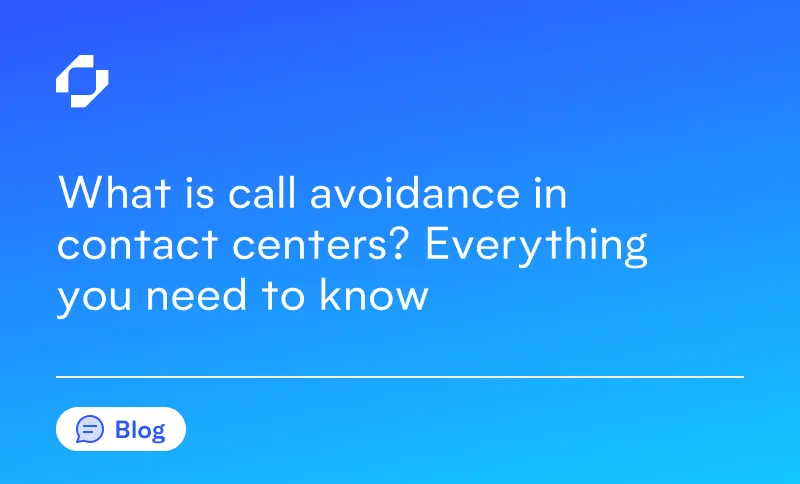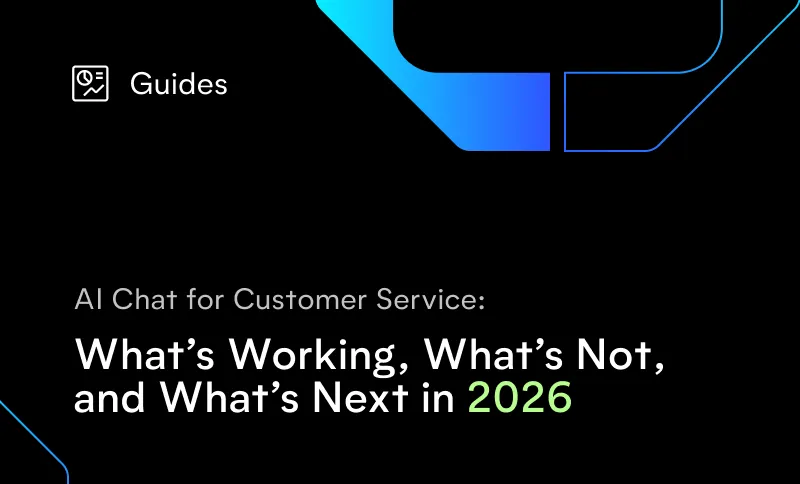
Contact centers face a persistent challenge that rarely makes headlines but silently erodes performance: call avoidance. It happens in contact centers of every size. What does it look like? Maybe an agent takes an extra-long "wrap up" after a call, or another mysteriously disappears during peak hours, while someone else habitually transfers perfectly manageable calls to colleagues. These behaviors aren't just random occurrences; they're symptoms of a deeper problem that spreads through teams, affecting everyone from frontline agents to managers to customers waiting on hold. When agents actively or unconsciously sidestep their call responsibilities, the entire customer service ecosystem suffers. Wait times balloon, resolution rates plummet, and the agents who do pick up calls face an unfair burden. For contact center leaders who want to improve customer experience, understanding why call avoidance happens and how to effectively address it is fundamental to building a thriving operation.
What is call avoidance?
Call avoidance in contact centers refers to the practices where agents intentionally or unintentionally avoid handling customer calls. These behaviors manifest in various ways, including:
- Extending wrap-up times unnecessarily
- Transferring calls that could be handled personally
- Logging off during scheduled shifts
- Taking prolonged breaks
- Deliberately misrouting calls to other departments
Unlike call resolution where either human or AI agents are effectively solving customer problems, call avoidance detracts from service quality and creates inefficiencies throughout the operation. It represents a symptom of deeper organizational issues rather than simply being a performance problem.
Why does call avoidance happen?
Understanding the root causes of call avoidance is crucial for addressing it effectively. Most instances stem from systemic challenges within the contact center environment:
- Agent Burnout: Continuous exposure to complex customer issues and high-pressure situations can lead to emotional exhaustion. When agents feel drained, avoidance becomes a self-preservation mechanism.
- Low Morale: Work environments with limited recognition, poor management, or inadequate support systems naturally lead to disengagement. Agents who don't feel valued are less motivated to tackle challenging calls.
- Inadequate Training: Agents lacking confidence in their ability to handle certain call types may actively avoid them. This insecurity often results from insufficient training or limited access to knowledge resources.
- Frustrating Workflows: Cumbersome systems, excessive manual processes, and disconnected tools make each interaction more difficult than necessary. When agents must navigate multiple systems for simple tasks, avoidance becomes tempting.
- High Call Complexity: Some contact centers routinely face extraordinarily complex customer issues requiring extensive problem-solving. Without proper support systems, agents may develop avoidance tendencies for these challenging interactions.
Addressing call avoidance effectively requires tackling these systemic issues rather than simply disciplining individual agents. Automation can help alleviate many of these challenges by streamlining processes and reducing repetitive tasks that contribute to burnout.
How call avoidance impacts contact centers
Unchecked call avoidance creates substantial negative consequences across the entire contact center operation:
Lower CSAT and extended resolution times
When calls are avoided, customers experience longer wait times, multiple transfers, and repeated explanations of their issues. This frustration directly translates to lower customer satisfaction scores and damages brand perception. Research consistently shows that customers who must explain their problem multiple times are significantly more likely to report negative experiences. The compounding effect of these interactions can linger long after the call ends, affecting future purchase decisions and customer loyalty.
Increased call abandonment rates
As customers encounter longer wait times due to agent avoidance behaviors, many simply hang up. These abandoned calls represent lost opportunities and potentially lost customers. Each abandoned call indicates a customer need that goes unmet, often sending them directly to competitors who can respond more promptly. Contact centers typically see a direct correlation between increased instances of call avoidance and rising abandonment metrics in their reporting dashboards.
Agent resentment and uneven workload distribution
Call avoidance creates an unfair burden on conscientious agents who consistently handle their assigned calls. This imbalance breeds resentment among team members and deteriorates workplace culture. High-performing agents quickly recognize patterns where certain colleagues routinely avoid difficult calls, creating an unofficial two-tier system within the team. At the same time, managers struggle with managing rising call volumes and more calls get routed to agents on the verge of burnout. This dynamic can spread rapidly through a contact center, undermining team cohesion and collaborative problem-solving efforts.
Burnout-driven turnover
The same conditions that cause call avoidance in contact centers also drive turnover. As avoidance behaviors increase, the workload shifts to fewer agents, accelerating burnout and creating a destructive cycle of attrition. The financial impact of this turnover extends beyond hiring costs to include knowledge loss, decreased team morale, and training investments that walk out the door with departing employees. Many contact centers find themselves trapped in this cycle, constantly training new hires while experienced agents continue to leave.
Declining performance metrics
Beyond CSAT, call avoidance negatively impacts numerous performance indicators including average handle time, first call resolution, and quality scores. These declining metrics can trigger management interventions that may exacerbate the underlying problems. As managers implement stricter controls to address the symptoms, agents often feel more pressure and less autonomy, further increasing their desire to avoid difficult interactions. This creates a downward spiral where heightened scrutiny leads to more sophisticated avoidance tactics.
Revenue impact
Ultimately, persistent call avoidance affects the bottom line through increased operational costs, customer churn, and missed upselling opportunities. The financial implications extend throughout the organization as resources are diverted to address escalations and complaints that originate from poorly handled calls. Companies with significant call avoidance problems typically see these effects reflected in their quarterly financial results, with customer lifetime value decreasing as service quality deteriorates.
Practical tips to minimize call avoidance
Implementing targeted strategies can significantly reduce call avoidance behaviors while improving overall contact center performance:
Automate repetitive, low-value interactions
Routine transactions like billing inquiries, password resets, and status checks can be successfully automated across multiple channels including voice, chat, and SMS with tools like Replicant. This automation reduces call volume for repetitive issues, allowing agents to focus on more complex and engaging customer interactions that require human empathy and problem-solving.
Automation helps prevent burnout by eliminating the monotony that leads many agents to develop avoidance behaviors in the first place. With fewer routine calls in the queue, agents can dedicate their energy to more meaningful customer interactions.
Improve call routing and context sharing
Smart routing ensures agents receive calls aligned with their expertise and training. When routing includes comprehensive context sharing, agents have the information they need to handle issues efficiently without requiring customers to repeat themselves.
At Replicant, we’ve seen clients who use effective routing automation both reduce agent frustration and minimize unnecessary transfers. This creates a more positive experience for both customers and agents, naturally reducing the incentive for avoidance behaviors.
Identify avoidance trends with analytics
Proactive monitoring of key metrics through tools like Conversation Intelligence can reveal patterns of call avoidance before they become entrenched behaviors. Important indicators to track include:
- Unusually long wrap-up times
- High transfer rates for specific call types
- Patterns of availability that don't align with call volume
- Selective handling of certain customer issues
Analytics that surface these trends allow for early intervention and support rather than punitive measures after problems escalate.
Coach with data, not assumptions
Data-driven coaching provides agents with specific, actionable feedback rather than vague directives or assumptions about performance. This approach helps identify:
- Specific call types that challenge particular agents
- Knowledge gaps that can be addressed through targeted training
- Process inefficiencies that create avoidance incentives
- Successful strategies used by high-performing team members
When coaching is supported by concrete data, agents receive the specific guidance they need to overcome challenges rather than feeling scrutinized or micromanaged.
Balance workload across agents
Equitable distribution of calls based on volume, complexity, and agent capacity prevents the overloading of high performers. Effective workforce management systems should:
- Monitor real-time adherence without creating a surveillance culture
- Adjust scheduling based on historical volume patterns
- Consider complexity factors when routing calls
- Provide flexibility within structured boundaries
This balanced approach prevents the situation where conscientious agents become overwhelmed while others engage in avoidance tactics.
Offer role variety to reduce fatigue
Monotony contributes significantly to call avoidance. Introducing variety through role rotation helps maintain engagement and prevent burnout:
- Alternate between different call types throughout shifts
- Balance emotionally taxing calls with more positive interactions
- Incorporate non-call activities like training, knowledge base updates, or quality reviews
- Provide opportunities for agents to develop specialized expertise
This variation prevents the fatigue that often leads to avoidance behaviors while expanding agent capabilities.
Keep knowledge easily accessible
Agents frequently avoid calls when they lack confidence in their ability to resolve issues. A centralized, easily searchable knowledge base can help you manage call avoidance by:
- Providing instant access to accurate information
- Reducing the stress of uncertainty
- Minimizing the need for transfers due to knowledge gaps
- Supporting consistent customer experiences
When information is readily available, agents feel empowered to handle a wider range of calls competently.
Recognize and reward engagement
Positive reinforcement for agents who consistently handle challenging calls well creates a culture that values engagement over avoidance:
- Publicly acknowledge agents who tackle difficult situations effectively
- Create recognition programs that highlight quality interactions, not just quantity
- Develop career advancement paths for consistently engaged agents
- Implement peer recognition systems that strengthen team cohesion
This approach shifts the cultural emphasis from avoiding difficult calls to masterfully handling them.
How Replicant helps address call avoidance
Contact centers struggling with call avoidance don't need another monitoring tool, they need solutions that eliminate the underlying causes. Replicant tackles these root issues head-on, creating an environment where avoidance behaviors naturally disappear.
Conversation automation for repetitive tasks
Picture this: Your agents arrive each morning knowing they won't spend hours repeating the same password reset instructions or reciting account balances. Instead, Replicant's Conversation Automation quietly handles these routine interactions across voice, chat, and SMS channels. The transformation is remarkable—agents escape the mind-numbing cycle of repetitive calls that drain enthusiasm and trigger disengagement.
While automation works tirelessly in the background (24/7, without breaks or burnout), human agents can invest their talent where it matters most—complex problem-solving and emotionally nuanced conversations that showcase their uniquely human abilities. This shift fundamentally changes the contact center dynamic by removing the very interactions that make agents want to hit the "avoid" button in the first place.
Conversation Intelligence for performance insights
Behind every pattern of call avoidance lies a story—one that Replicant's Conversation Intelligence reveals with remarkable clarity. Rather than leaving managers to guess why certain agents avoid specific call types, the system uncovers hidden patterns and emerging trends before they become entrenched problems.
These insights transform coaching conversations from awkward confrontations into collaborative problem-solving sessions. Instead of vague directives like "take more calls," managers can address specific challenges: "I notice billing disputes seem particularly challenging—let's review some successful approaches together." This precision builds confidence rather than anxiety, turning potential avoiders into engaged problem-solvers. When agents see issues as solvable challenges rather than overwhelming burdens, the motivation to avoid naturally diminishes.
Improved agent experience and retention
The daily reality for agents using Replicant feels fundamentally different. Gone are the emotional rollercoasters of handling repetitive complaints that drain resilience and trigger avoidance behaviors. The constant friction of juggling multiple systems disappears, replaced by streamlined workflows that make doing the job correctly easier than avoiding it.
This transformation creates a virtuous cycle where agents engage more deeply with meaningful work, building expertise and confidence that further reduces avoidance tendencies. Southwest Medical Imaging witnessed this shift firsthand, answering 20% more calls after implementation—not by pushing agents harder, but by creating conditions where engagement became the path of least resistance. Their experience demonstrates how addressing the underlying causes of avoidance doesn't just solve a problem, it transforms the entire contact center ecosystem into a healthier, more productive environment where both agents and customers thrive.
Conclusion
Call avoidance presents a significant challenge for contact centers, impacting both agent well-being and customer experience. The behaviors themselves (extended wrap-up times, unnecessary transfers, strategic unavailability, etc) are symptoms of deeper systemic issues that require thoughtful intervention.
You can prevent call avoidance by supporting agents through improved workflows, adequate training, balanced workloads, and recognition of positive engagement. It also requires implementing technological solutions that reduce the conditions that foster avoidance in the first place.
By tackling the root causes rather than simply monitoring for avoidance behaviors, contact centers can create environments where agents feel empowered to handle customer interactions confidently and effectively. The result is not just reduced avoidance but improved operational efficiency, higher customer satisfaction, and better agent retention.
See how Replicant reduces repetitive work, improves routing, and supports agents. Request a demo with our team to learn more about creating a contact center environment where avoidance evaporates.



.svg)



